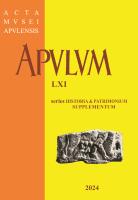RECEPTAREA OPERELOR LUI SCHONAEUS ȘI ROSAEUS ÎN ȘCOLILE REFORMATE MUREȘENE ȘI CLUJENE DIN SECOLUL AL XVII-LEA. INTROSPECȚIE FILOLOGICĂ ȘI BIBLIOTECONOMICĂ ÎN INTERPRETAREA OPERELOR LUI VERGILIU ȘI TERENȚIU
The Reception of the Works of Schonaeus and Rossaeus in the 17th Century Reformed Schools of Mureș and Cluj. Philological and Librarianship Introspection in the Interpretation of the Works of Vergilius and Terentius
Author(s): Örs DóczySubject(s): History, Cultural history, Modern Age, 17th Century
Published by: Muzeul National al Unirii Alba Iulia
Keywords: Puritanism; poetics; spiritual repentance; common spiritual heritage; edition; 17th century;
Summary/Abstract: Since both Terentius Christianus and Vergilius Evangelizans deal with the problem of conversion, and of repentance, the works can be understood through the prism of the writings of the early Christian church fathers in terms of evaluating and mobilizing the spiritual faculties (intellectus, memoria, voluntas), faculties appropriated which are disputed in the works of Perkins and Amesius. In the works of Schonaeus and Rosaeus, we can first of all observe the primacy of the intellect, which is the beginning of the will. Drawing on a common spiritual and intellectual treasury, namely the books of the Bible, the classical and Hellenistic Greek and Roman comedies and dramas, and the Vergilian epics, the two volumes offer the same spiritual repentance of Perkinsian and Amesian pattern which was the Puritan way of conversion of the Christian man, of early Christian origin: man must first recognize that he wants to reach the true spiritual life (voluntas), he must know the obstacles that arise from sin and the human body, the causes of spiritual and physical temptations (empiria), and then faith, since there is consolation for every fall and the possibility of performing pious acts (pietas) and of union with Christ (unio mystica cum Christo). The acceptance and reception of the two works by all denominations is ensured precisely by the use of the common spiritual heritage of antiquity and Christian antiquity, through the literary fusion, reflection and "subsequent creation" of the two cultures.Regarding the editions of Schonaeus and Rosaeus' works on the territory of the Principality of Transylvania, we consider, that the editions of Rosaeus and Schonaeus in Oradea, in the printing house of Ábrahám Szenci Kertész, and of Töltesi in Debrecen were "fashionable" and served as textbooks or, after 1656, as private readings in the Helvetic colleges of the two cities but also in adjacent areas. Once because in the partial synod of Baia Mare, convened by pastors interested in reorganizing the church by introducing lay curates into its leadership and open to Puritan ideas, but also with the support of Princess Zsuzsanna Lorántffy they decided to organize the presbytery in the Transylvanian ecclesiastical dioceses. Thus, both in the churches in the area between Tisa and Baia Mare, the Maramureș Region to Oradea, as well as in the schools related to these localities, Rosaeus and Schonaeus' editions of poetics were compulsory material until 1656 at the local school education during the syntactic and poetic classes. However, the mentioned works appeared in Oradea just after the fierce regulations of Prince György Rákóczi II, mentioned in the first part of the new civil code Approbatae, accepted in 1653 by the orders of the Principality. Thus, the prince, as the supreme patron of the churches in the principality, regulates the rules for conducting academic pilgrimages, and, last but not least, takes measures to prevent the spread of innovations such as Puritanism: any innovation is possible only in the general synods of the ecclesiastical orders, and if anyone promotes innovations against the foundations of faith and religion, he is reprimanded and sentenced to death. Bendek Nagyari and his colleagues, teachers of the Helvetic College of Oradea, are imprisoned and then forced to base their sermons on the episcopal ecclesiastical doctrines, the only doctrines accepted by Prince György Rákóczi II. The appearance of the works of Rosaeus and Schonaeus in 1656, in Oradea can be explained in the following way: they make use of the common spiritual heritage of antiquity and Christian antiquity, through literary transcription, through the fusion of the two cultures, so that they cannot be interpreted either before 1653 or after 1656 as exclusive sources and literatures of Puritanism, as sources for understanding the Puritan educational programme, nor for the Puritan interpretation of the Latin textual sources of the early modern period. The books of Schonaeus and Rosaeus remained in the Principality of Transylvania even after 1656 as private, library sources for Latin learning, because of their literary, linguistic, semantic complexity and not least because of their confessional neutrality, which is why they were accepted as optional readings by the educational programs in the Principality. Thus, we can explain the significant presence of these works with their 16th, 17th and to a large extent 18th century editions in college and private libraries. The limit of appearance of these works is linked to the date of the decree reorganising the educational system in the Habsburg Empire in 1776. From this year onwards, the compulsory readings for poetry classes in the Helvetic colleges in Transylvania will be the works of Ovidius, Vergilius and Horatius' odes.
Journal: Apulum
- Issue Year: 61/2024
- Issue No: 1
- Page Range: 219-240
- Page Count: 22
- Language: Romanian
- Content File-PDF

